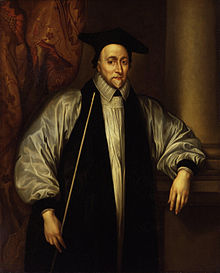William Juxon(1582 – 4 June 1663) was anEnglishchurchman,Bishop of Londonfrom 1633 to 1646 andArchbishop of Canterburyfrom 1660 until his death.[2]
William Juxon | |
|---|---|
| Archbishop of Canterbury | |
 | |
| Church | Church of England |
| Province | Province of Canterbury |
| Diocese | Diocese of Canterbury |
| Elected | 13 September 1660 (elected); 20 September 1660 (election confirmed),Henry VII Chapel,Westminster Abbey |
| Installed | 25 September 1660 |
| Term ended | 4 June 1663 (death) |
| Predecessor | William Laud |
| Successor | Gilbert Sheldon |
| Other post(s) |
|
| Personal details | |
| Born | 1582 Chichester,Sussex,England |
| Died | 4 June 1663 (aged approximately 81) Lambeth,Surrey,England |
| Buried | 9 July 1663, Chapel ofSt John's College, Oxford |
| Nationality | English |
| Denomination | Anglican |
| Parents | Richard Juxon |
| Occupation | also aminister of the Crown |
| Profession | Lawyer;academic |
| Education | Merchant Taylors' School |
| Alma mater | St John's College, Oxford |
| Signature | |
Ordination history of William Juxon | |||||||||||||||||||
|---|---|---|---|---|---|---|---|---|---|---|---|---|---|---|---|---|---|---|---|
| |||||||||||||||||||
| Source(s):[1] | |||||||||||||||||||
Life
editEducation
editJuxon was the son of Richard Juxon and was born probably inChichester,and was educated at the local grammar school,The Prebendal School.[3]He then went on toMerchant Taylors' School,London,andSt John's College, Oxford,where he was elected to a scholarship in 1598.
Ecclesiastical offices
editJuxon studied law atOxford,but afterwards took holy orders, and in 1609 became vicar ofSt Giles' Church, Oxford,where he stayed until he became rector ofSomerton, Oxfordshirein 1615. In December 1621, he succeeded his friend,William Laud,asPresident(i.e. head) of St John's College, and in 1626 and 1627 he wasVice-Chancellor of the University of Oxford.Juxon soon obtained other important positions, including that in 1632 ofClerk of the ClosettoKing Charles I.
In 1627, he was madeDean of Worcesterand in 1632 he was nominated to the See of Hereford and resigned the presidency of St John's in January 1633. Though he legally becameBishop of Herefordby theconfirmation of his electionin late July 1633,[4]he never took up duties at Hereford, as in October 1633 he was consecratedBishop of Londonin succession to Laud.
Secular offices
editIn March 1636 Charles I entrusted Juxon with important secular duties by making himLord High Treasurerof England as well asFirst Lord of the Admiralty;for the next five years he had to deal with many financial and other difficulties. He resigned the treasurership in May 1641. During theCivil War,the bishop, against whom no charges were brought in parliament, lived undisturbed atFulham Palace.His advice was often sought by the king, who had a very high opinion of him. The king selected Juxon to be with him on the scaffold and to offer him the last rites beforehis execution.
Retirement and archbishopric
editJuxon was deprived of the See of London by Parliament on 9 October 1646, and episcopacy was abolished for the duration of theCommonwealthand theProtectorate.[5][6]He retired toLittle ComptoninGloucestershire(now inWarwickshire), where he had bought an estate, and became famous as the owner of a pack of hounds. At therestorationofCharles II,letters missive were issued (on 2 September 1660) naming Juxon (restored Bishop of London) Archbishop of Canterbury.
Thecongé d'élirewas issued the next day and the chapter ofCanterburyduly elected him on 13 September. The king's assent to the election was given on 15 September and the confirmation of Juxon's election (the legal ceremony by which he took office) was held in theHenry VII ChapelofWestminster Abbeyon 20 September 1660.[a][7]He received thetemporalitieson 22 September and was enthroned atCanterburyon 25 September.[8]Juxon, as Archbishop of Canterbury, then took part in the new king's coronation, but his health soon began to fail and he died atLambethin 1663. By his will the archbishop was a benefactor to St John's College, where he was buried; he also aided the work of restoringSt Paul's Cathedraland rebuilt the great hall atLambeth Palace.
Memorials
editJuxon House,which stands north-west of St Paul's Cathedral at the top ofLudgate HillinLondonand forms part of thePaternoster Squaredevelopment, is named after him.Juxon Streeton land atWalton Manorformerly owned by St John's College in the inner-city suburb ofJericho, Oxford,is also named after him[9]as is another Juxon Street atLambeth Walk,close to Juxon's former residence atLambeth Palace.
Notes
edit- ^The bishops present to confirm Juxon's election were:Accepted Frewen,Archbishop-designate of YorkandBishop of Lichfield and Coventry;Brian Duppa,Bishop-elect of WinchesterandBishop of Salisbury;William Piers,Bishop of Bath and Wells;Matthew Wren,Bishop of Ely;Robert Skinner,Bishop of Oxford;William Roberts,Bishop of Bangor;John Warner,Bishop of Rochester;andHenry King,Bishop of Chichester.
- ^Perceval, A. P."An Apology for the Doctrine of Apostolical Succession: with an Appendix on the English Orders".p. 204.
- ^Mason, Thomas (1985).Serving God and Mammon: William Juxon, 1582–1663.University of Delaware Press.ISBN978-0-87413-251-9.
- ^Haivry, Ofir (29 June 2017).John Selden and the Western Political Tradition.Cambridge University Press. p. 11.ISBN978-1-107-01134-2.
- ^"Juxon, William".Oxford Dictionary of National Biography(online ed.). Oxford University Press.doi:10.1093/ref:odnb/15179.(Subscription orUK public library membershiprequired.)
- ^Plant, David (2002)."Episcopalians".BCW Project.Retrieved25 April2021.
- ^King, Peter (July 1968). "The Episcopate during the Civil Wars, 1642-1649".The English Historical Review.83(328). Oxford University Press: 523–537.doi:10.1093/ehr/lxxxiii.cccxxviii.523.JSTOR564164.
- ^Lambeth Palace Library Research Guide – Places of Confirmation of Election of Archbishops of Canterbury[usurped](Accessed 31 July 2013)
- ^Horn, Joyce M. (1974),Fasti Ecclesiae Anglicanae 1541–1857,vol. 3, pp. 8–12
- ^"Juxon Street".jerichocentre.org.uk.Retrieved12 November2018.
References
edit- This article incorporates text from a publication now in thepublic domain:Chisholm, Hugh,ed. (1911). "Juxon, William".Encyclopædia Britannica.Vol. 15 (11th ed.). Cambridge University Press. p. 618.
External links
edit- Hutton, William Holden(1892)..Dictionary of National Biography.Vol. 30.